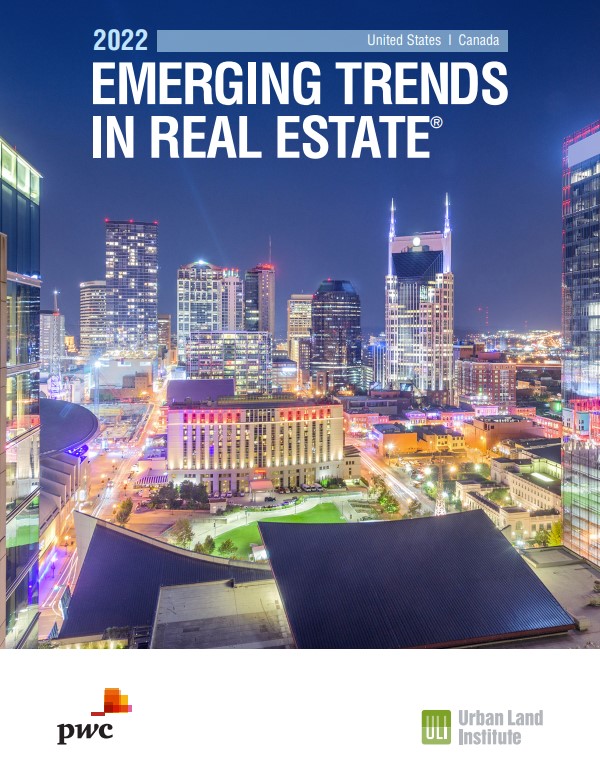 Despite potential storm clouds ahead, survey results from the Emerging Trends in Real Estate® 2022 report, produced jointly by ULI and PwC, show strong optimism in the industry about the coming year, speakers said Thursday at a Fall Meeting session on the report.
Despite potential storm clouds ahead, survey results from the Emerging Trends in Real Estate® 2022 report, produced jointly by ULI and PwC, show strong optimism in the industry about the coming year, speakers said Thursday at a Fall Meeting session on the report.
Eighty-four percent of survey respondents expect 2022 to be better than 2021, exceeding the 79 percent who held a similar view about the coming year in 2019. It also is the highest level of optimism about the coming year since 2016. It remains to be seen whether that buoyancy is a “sugar high” bounce-back fueled by the massive federal stimulus pumped into the U.S. economy, noted Andrew Warren, director of real estate research at PwC. In addition, potential headwinds still loom regarding issues such as inflation, labor, supply-chain disruption, geopolitics, and potential tax changes.
What is clear is that when the country reaches its “next normal,” it will not be the same. “Things will change,” Warren said. In particular, the desire for flexibility and convenience will drive change in real estate not only in 2022, but also over the next decade. Trends identified in the report, including the potential to work anywhere and live anywhere, could transform buildings, markets, and investment decisions.
“Overall, what jumps out here is optimism. It’s very clear that, not only do we feel good about the sugar rush, but also looking forward,” said Amy Price, president and co-head of the U.S. investment management business at BentallGreenOak. Another notable finding in the report is recognition of the commercial real estate industry’s role in diversity, equity, and inclusion. “Seventy percent of respondents felt that, as an industry, we have the power to influence and address systemic racism going forward, which is pretty amazing,” she said.
The survey results and trends identified in the report highlight the change that is coming. Some elements of change were underway before the pandemic, such as the retail revolution and relocation of aging millennials to the suburbs. The pandemic added a shot of steroids to some of those trends and also fostered new trends, said Hessam Nadji, president and chief executive officer of Marcus & Millichap. “I don’t think it is a sugar rush. It is sustainable and fundamentals-driven in terms of what we’re seeing and what is reflected in the report, but there is a lot of change coming,” he said.
On the investment side, there is clear evidence that optimism is sustainable. For example, transaction activity has come roaring back and surpassed 2019 levels. That rise in activity is more than just pent-up demand, Nadji said; it is yield driven. In addition, capital is coming in from institutions and private investors. In fact, many people have waked up to the fact that real estate needs to be a part of investment portfolios, he said.
Environmental, social, and governance (ESG) factors and climate risk are another issue that has come to the forefront, with more change ahead for 2022. “From my perspective, ESG and climate have always been important. The difference now is that everyone thinks they are important,” said Bradford Dockser, chief executive officer and cofounder of Green Generation. Eighty-two percent of respondents said they are making decisions today based on climate and ESG issues, whether it is where they buy, how they underwrite, or how they think about their assets.
“It is now an issue that can’t be ignored, and it is clearly an issue that is creating winners and losers,” said Dockser. “It is the same coin; risk is on one side and opportunity on the other.” Organizations are not only going to face greater regulatory requirements, but also how they embed sustainability in their investment process will affect key issues such as their ability to access capital, he added.
“As we think about ESG, diversity and inclusion, and the other social issues that are falling on the shoulders of our industry to create solutions, that’s clearly a standout issue that has come out this year and also in the report last year,” noted R. Byron Carlock, leader of the U.S. real estate practice at PwC.
Trends highlighted in the report include the following:
- A brief and muted real estate downturn. The overall economy has seen a rebound far exceeding expectations. Not only has economic output already recovered to pre-pandemic levels, but also growth is forecast to be at its highest rate in decades in 2021 and 2022.
- The housing affordability crisis. Housing affordability worsened during the pandemic. With housing production falling far short of new household formations, affordability will likely continue to deteriorate in the absence of significant public- and private-sector intervention.
- Working from home may mean less need for office space. Industry leaders predict that the need for office space will likely decrease 5 to 15 percent within the next three years. Office tenants will look to redesign the space they have and do more with less to accommodate new ways of hybrid working.
- The great relocation? The number of highly paid office workers making the move away from their workplace has been relatively limited. Potential employee moves could rise as firms delay the return to work or formally make remote work a permanent option.
- Investment in alternative sectors. Real estate investment trusts (REITs) and private investors have been much quicker to embrace a broader variety of “alternative” sectors, ranging from niches such as student housing, to life sciences, data centers, and cold storage.
- The maturation of proptech. The pandemic provided new impetus and scope for adoption of property technology as the need to better assess and allocate investments and to understand and manage properties accelerated sharply.



